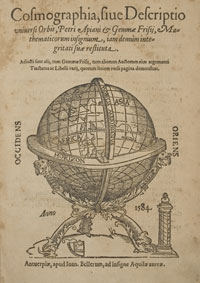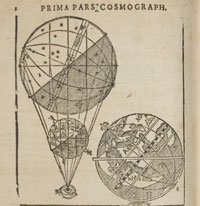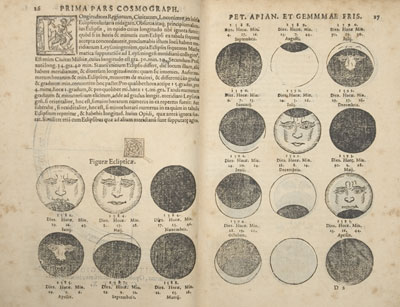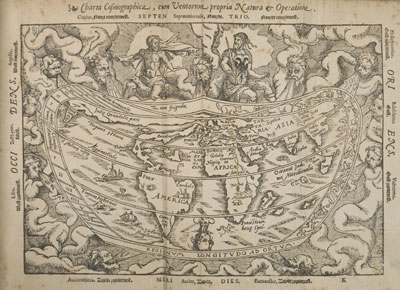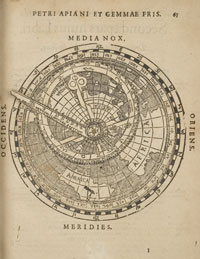Cosmography, or Description of the universal sphere, by Petrus Apianus & Gemma Frisius
(Antwerp, 1584)
Acquired by the Department, Summer 2009, to augment the Whipple's important collection of early Apian editions.
Peter Apian (1495–1552) was born in Leisnig in Saxony and moved to Leipzig and then Vienna to pursue studies in mathematics and astronomy, among other mathematical subjects. He was appointed Professor of Mathematics at Ingolstadt in 1527. In 1540, Apian presented his sumptuous Astronomicon Caesareum to Emperor Charles V, earning him special favour with the ruler. This work featured several moving parts which demonstrate Apian's practical attitude to astronomical matters.
Apian first published his Cosmographia in 1524, featuring three circular devices with moving parts, called volvelles. Later on, Gemma Frisius (1508–1555), a Dutch physician, instrument maker and mathematician, produced several expanded editions of the Cosmographia with an additional volvelle. The Frisius editions were published more widely than the original work.
Click on the images to enlarge
Peter Apian and Gemma Frisius: The Cosmographia of 1584
Apian's Cosmographia, as expanded by Frisius, is not the only work in the Whipple Library volume, published in Antwerp in 1584. Bound with Apian's work are several descriptions of places by other authors, as well as a selection of Frisius' independently authored instrument books. Several of these works presented new instrument designs and gave instructions on how they were to be used.
The Cosmographia itself was a guide to the discipline of cosmography, which Apian described as 'the description of the world (which consists of four elements, Earth, Water, Air, & Fire), also of the Sun, the Moon, & all the stars, & of the heavens with whatever vault covers them.' 1 In other words, cosmographers described the earth in relation to the heavens, rather than looking at the globe or specific lands alone. This conception is embodied in this famous image depicting Earth as seen by the divine eye in relation to the sphere of the fixed stars.2
As well as information on the correspondence between the circles used to divide the earth, such as the equator, and those used to divide the heavens, such as the zodiac, the Cosmographia featured sections on eclipses, constellations and units of measurement.
There were also descriptions of various towns and cities, complemented by a fold-out chart showing the operation of the winds across the globe. This is very significant as one of the earliest published maps to include North America.
A practical book
The volvelles make the practical nature of cosmography clear. Readers could manipulate these devices to solve problems: finding the time at different places and or one's latitude, given the height of the Sun above the horizon. However, these devices would have added to the cost of the book. Perhaps to save money, several of the moving parts have been printed on the back of paper that had already been used – an interesting case of 16th-century recycling!
The practical nature of cosmography as presented by Apian and Frisius made Frisius' instrument books suitable texts to bind at the end of the work. A contents page summarising these works printed on the reverse of the title page indicates their inclusion in the original 1584 edition of Cosmographia. Cosmography and instruments were closely related.
Considering the practical nature of cosmography, and the fact that readers were meant to manipulate the volvelles to solve problems, we are remarkably fortunate that the volvelles in the Whipple volume are still intact!
Katie Taylor
References
1 Apian (1584) p. 1.
2 D. Bertoloni Meli & J. A. Bennett, Sphaera Mundi: Astronomy Books in the Whipple Museum, 1478–1600 (Cambridge, 1994), p. 84.

